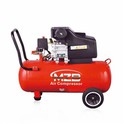Working principle of air compressor: After the driver is started, the triangular belt drives the compressor crankshaft to rotate, which is converted into piston reciprocating motion in the cylinder through the crank connecting rod mechanism. When the piston moves from the cover to the shaft, the cylinder volume increases, and the pressure inside the cylinder is lower than atmospheric pressure. External air enters the cylinder through the filter and suction valve; After reaching the bottom dead center, the piston moves from the shaft to the cover side, the suction valve closes, the cylinder volume gradually decreases, and the air inside the cylinder is compressed, resulting in an increase in pressure. When the pressure reaches a certain value, the exhaust valve opens and compressed air enters the air storage tank through the pipeline. Work,
Continuously deliver compressed air to the air storage tank, gradually increasing the pressure inside the tank to obtain the required compressed air.
Detailed process of the working principle of the air compressor:
1. Inhalation process:
The suction port on the intake side of the screw compressor should be designed as a compression chamber that can fully absorb air, while the screw compressor does not have an intake and exhaust valve group, and the intake is only adjusted through the opening and closing of the valve. A regulating valve. When the rotor rotates, the slot space between the main and auxiliary rotors is large when turning to the opening of the intake end wall. At this point, the slot space of the rotor is connected to the free air at the air inlet. It is completely exhausted. After the exhaust is completed, the teeth are in a vacuum state. When turning to the air inlet, external air is sucked in and flows axially into the teeth of the main and auxiliary rotors. When the air fills the entire tooth slot, the end face of the rotor inlet side rotates away from the casing inlet, and the air between the teeth slots is sealed. The above is the intake process. Sealing and conveying process: When the suction of the main and auxiliary rotors ends, the tooth peaks of the main and auxiliary rotors are closed to the casing. At this point, the air is sealed in the tooth groove and no longer flows out, which is the sealing process. The two rotors continue to rotate, their tooth peaks and grooves match at the suction end, and the matching surface gradually moves towards the discharge end, which is the conveying process. Compression and fuel injection process: During the transportation process, the meshing surface gradually moves towards the exhaust end, meaning that the gap between the meshing surface and the exhaust port gradually decreases, and the gas in the tooth slot is gradually compressed, resulting in an increase in pressure. This is the compression process. At the same time of compression, due to the pressure difference, lubricating oil is also sprayed into the compression chamber and mixed with air.
2. Exhaust process:
When the meshing end face of the rotor rotates and communicates with the exhaust of the casing, (at this time, the compressed gas pressure is very high) compressed gas begins to exhaust, until the tooth top and tooth groove meshing surface move to the exhaust end face. At this time, the groove space between the two rotor meshing surfaces and the exhaust port of the casing is zero, indicating that the exhaust process is completed. At the same time, the length of the groove between the meshing surface of the rotor and the inlet of the casing reaches a very long point, and the suction process is carried out again.
3. Compression and injection process:
During the transportation process, the meshing surface gradually moves towards the exhaust end, meaning that the gap between the meshing surface and the exhaust port gradually decreases, and the gas in the tooth slot is gradually compressed, resulting in an increase in pressure. This is the compression process. At the same time as compression, lubricating oil is also sprayed into the compression chamber, which mixes with the indoor air due to the pressure difference.
4. Exhaust process:
When the meshing end face of the rotor rotates and communicates with the exhaust of the casing, (at this time, the pressure of the compressed gas is very high) the compressed gas begins to exhaust until the tooth top meshing surface communicates with the tooth top meshing surface. The tooth groove moves towards the exhaust end face, and at this point, the tooth groove gap between the meshing surfaces of the two rotors and the exhaust port of the casing is zero, completing the exhaust process. At the same time, the length of the teeth between the meshing surface of the rotor and the air inlet of the casing reaches a very long level, completing the suction process. In progress again.
Apr 11, 2023
Detailed Process Of The Working Principle Of The Air Compressor
Send Inquiry







